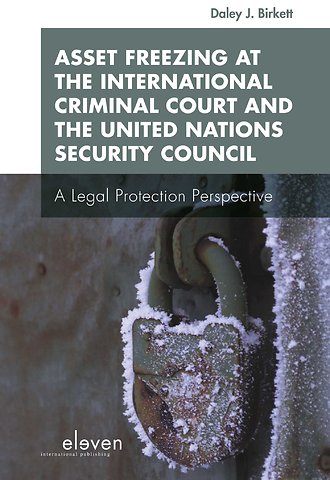



Daley J. Birkett, LL.M. (cum laude) (2012), Leiden University, is Legal Consultant at the United Nations Assistance to the Khmer Rouge Trials (UNAKRT) in the Extraordinary Chambers in the Courts of Cambodia.
Meer over Daley BirkettAsset Freezing at the International Criminal Court and the United Nations Security Council
A Legal Protection Perspective
Samenvatting
The International Criminal Court (ICC) and the United Nations Security Council (UNSC) are both empowered to request States to freeze individuals’ assets. Regardless of their duration, such measures necessarily infringe upon the targets’ rights. Yet, the longer assets are frozen, the more acute these infringements can become. ICC-requested asset freezes can endure from the issuance of an arrest warrant until the accused is acquitted or convicted, whereas UNSC ordered measures continue until international peace and security is restored. Asset freezes executed at the behest of the ICC and the UNSC are therefore rarely short in duration.
The focus of this book rests on the two bodies’ exercise of their asset freezing powers, with a particular emphasis on the legal protections available to the individuals at the receiving end of the procedures with which the ICC and the UNSC are equipped.
This book will be of interest to practitioners, academics, government officials, members of civil society, and postgraduate students with an interest in public international law, especially international criminal justice and international human rights law.
Trefwoorden
Specificaties
Inhoudsopgave
Table of Instruments ix
Table of Cases xv
1 Introduction 1
1.1 Framing the issue 1
1.2 Developing the research question 1
1.3 Methodology 3
1.4 Roadmap 5
2 Asset Freezing: Theory, Objects and Purposes 9
2.1 Introduction 9
2.2 Asset Freezing and Confiscation 9
2.2.1 Defining the Parameters 10
2.2.1.1 Conviction-based confiscation 12
2.2.1.2 Non-conviction-based confiscation 15
2.2.2 Justifying the Confiscation and Freezing of Assets 16
2.2.2.1 Punitive 17
2.2.2.2 Preventive 18
2.2.2.3 Restorative 19
2.2.2.4 Other 19
2.3 Situating ICC- and UNSC-Requested Asset Freezing Measures 20
2.4 Conclusion 24
3 Coexistent but Uncoordinated – Asset Freezing Measures at the ICC and the UNSC 25
3.1 Introduction 25
3.2 Modalities 26
3.3 Shared Goals? 28
3.4 Strengthening Cooperation 32
3.5 In Search of Coordination 36
3.5.1 Libya: Coexistent and Coordinated? 37
3.5.2 Coexistent but Uncoordinated 40
3.5.2.1 Democratic Republic of the Congo 40
3.5.2.2 Côte d’Ivoire 51
3.5.2.3 Sudan 55
3.5.2.4 Central African Republic 57
3.5.2.5 Mali 61
3.5.3 Neither Coexistent nor Coordinated 63
3.5.3.1 Uganda 63
3.5.3.2 Kenya 64
3.6 Conclusion 65
4 Recovering Assets at ICTs – Fines, Forfeiture and Orders for Reparations 67
4.1 Introduction 67
4.2 The Post-World War II Military Tribunals 67
4.3 The Ad Hoc International Criminal Tribunals 71
4.4 The Rome Statute System 73
4.4.1 Fine and Forfeiture Measures 73
4.4.2 Orders for Reparations 77
4.5 ICTs Established after the Adoption of the Rome Statute 79
4.5.1 The Special Court for Sierra Leone 79
4.5.2 The Special Panels for Serious Crimes 81
4.5.3 The Iraqi High Tribunal 82
4.5.4 The Extraordinary Chambers in the Courts of Cambodia 82
4.5.5 The Special Tribunal for Lebanon 83
4.5.6 The Extraordinary African Chambers 84
4.5.7 The Kosovo Specialist Chambers 85
4.6 Some Suggested Reasons behind ICTs’ Failure to Order Asset Recovery Measures 87
4.6.1 Theoretical Basis 87
4.6.2 Dearth of Assets 88
4.6.3 Other Reparations Paradigms 88
4.7 Conclusion 89
5 Pre-Trial ‘Protective Measures for the Purpose of Forfeiture’ at the ICC – Protecting and Balancing Competing Rights and Interests 91
5.1 Introduction 91
5.2 Protective measures at the ICC 92
5.2.1 The evidentiary threshold 93
5.2.2 Prior notification and modification 94
5.2.3 The right to appeal 95
5.2.4 The ‘rights of the parties concerned’ and ‘the ultimate benefit of victims’ 96
5.2.4.1 Accused persons 96
5.2.4.1 The Prosecutor 98
5.2.4.3 Victims 99
5.2.4.4 Bona fide third parties 99
5.3 The ICC practice 100
5.3.1 The purpose of protective measures and the range of assets susceptible thereto 101
5.3.2 Balancing competing rights and interests in the protective measures process 106
5.4 Concluding remarks 112
6 UNSC-Requested Asset Freezes and the Legal Protection of Individuals 115
6.1 Introduction 115
6.2 The Evolution of UNSC Sanctions: From General to Targeted Measures 115
6.3 Identifying (Quasi-)Legal Protections 118
6.3.1 Exemptions 118
6.3.2 The Focal Point for de-Listing 120
6.3.3 Other (Quasi-)Legal Protections 122
6.4 Conclusion 128
7 Asset Freezing attheEuropean and Inter-AmericanCourts ofHuman Rights – Lessons for the ICC, the UNSC and States 129
7.1 Introduction 129
7.2 Asset Freezing in the Law and Practice of the Strasbourg and San José Courts 131
7.2.1 Protection of property 135
7.2.1.1 Džinić v Croatia 136
7.2.1.2 Chaparro Álvarez and Lapo Íñiguez v. Ecuador 144
7.2.2 Right to respect for private and family life 147
7.2.2.1 Nada v Switzerland 148
7.2.2.2 The need for clear reasoning at the ICC 150
7.3 Conclusion 153
8 Managing the Frozen Assets of Accused Persons at the ICC – The
Fallout of the Bemba Acquittal 155
8.1 Introduction 155
8.2 The Bemba Case 158
8.2.1 (Un)freezing Bemba’s Assets 158
8.2.2 Bemba’s Claim for Compensation and Damages 164
8.3 Domestic Approaches 169
8.3.1 Third party management of seized or frozen assets 170
8.3.2 Use or Sale of Frozen Assets 172
8.4 International Responses 175
8.4.1 Utilising Article 96(3) of the ICC Statute 175
8.4.2 Lessons from Article 106 of the ICC Statute 176
8.4.3 Amending Article 85(3) of the ICC Statute? 177
8.5 Conclusion 179
9 Conclusion 181
Bibliography 189
Anderen die dit e-book kochten, kochten ook
Rubrieken
- cadeauboeken
- computer en informatica
- economie
- filosofie
- flora en fauna
- geneeskunde
- geschiedenis
- gezondheid
- jeugd
- juridisch
- koken en eten
- kunst en cultuur
- literatuur en romans
- mens en maatschappij
- naslagwerken
- non-fictie informatief/professioneel
- paramedisch
- psychologie
- reizen
- religie
- schoolboeken
- spiritualiteit
- sport, hobby, lifestyle
- thrillers en spanning
- wetenschap en techniek
- woordenboeken en taal





